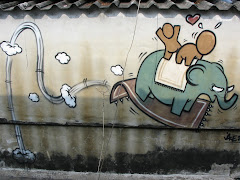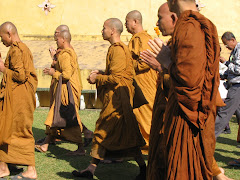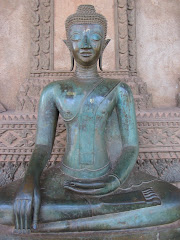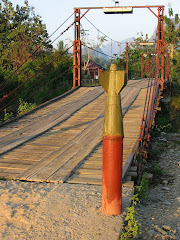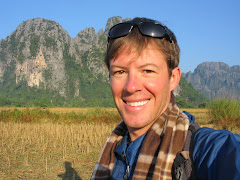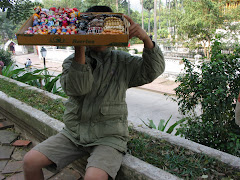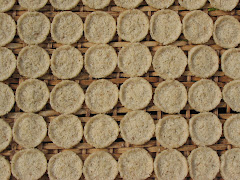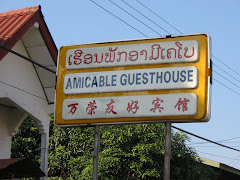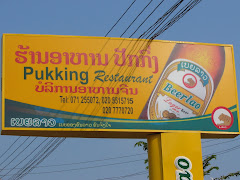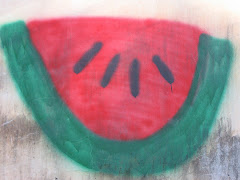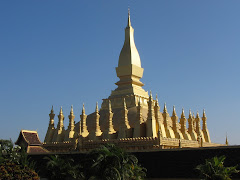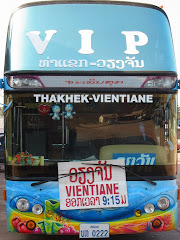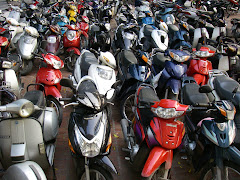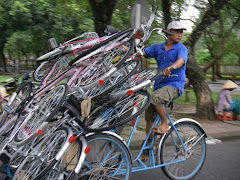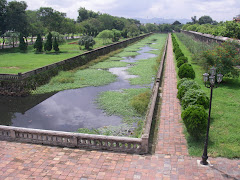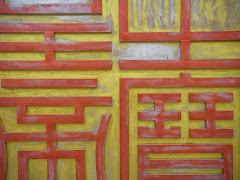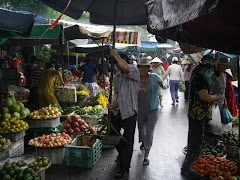
Pulling out of Son La, the very first sight I encountered was the huge CAT backhoe that had been clearing the road the day before. This time however, it sat squarely upside down - the operators cage crushed, tank treads sticking straight in the air - a few feet off the road and down the slope into town. No idea what happened other than the waterlogged road gave way under its weight and over and down it went. I hope that it was a slow-motion event giving the driver plenty of time to get out because he could not have survived otherwise. After amusing a gaggle of locals by taking a photo, I was off in the direction of the wrecked bridge that had stopped me the day before. When I got there, I could see that it hadn't really been repaired, but overnight the swollen river had dropped back to a trickle and I was able to get the bike across without even getting the tailpipe wet.
The skies had cleared - beautiful blue - and I had an amazing, trouble free drive all the way to Dien Bien Phu (161 km). Took me the better part of the day as the road wound up and over mountain passes, into and out of ravines, and along rivers (looking much tamer than a few days before). There had been dozens of landslides along the route but all had been cleared just enough to permit the passage of vehicles, even if it required slopping through mud. I was amazed by the VIetnamese highway system (yep, this was "Highway 6"). After miles of muddy, washboarded roads, I'd run into stretches seemingly in the middle of nowhere that were immaculately paved. Then more crud. A good stretch. Crud. Good. Crud. And so on. But the scenery was spectacular: jagged peaks drenched in green, small montagnard villages, and mostly empty roads. For hours I ended up dodging more water buffalo, pigs, and dogs than other vehicles.
"Dien Bien Phu" had become my mantra over the few days, if only for the reason that, looking at my map, it kind of resembled a midway point on my journey. I had heard the town was nothing special (it wasn't), but Dien Bien Phu is one of those mythical places in the history of Vietnam, and more specifically, warfare in Vietnam. The French were routed by the Vietminh there in 1954 (eventually setting the stage for American intervention) and since I was in the "neighborhood" I wanted to see it. It was also a convenient place to crash for the night.
The valley that Dien Bien Phu is situated in is gorgeous - maybe 10 miles long by 6 miles wide, surrounded by rice fields in the flats and big, green mountains at its edges. The city is pretty blah, as predicted, and it was hard to picture the pivotal battle that had taken place here fifty-something years ago. Lots of run down monuments to the Vietnamese side, a French memorial to its fallen soldiers, scattered war junk - tanks, cannons, rusted jeeps (mostly American, as it turns out. The Vietnamese were using weapons given to them by the Chinese who had taken them from the Americans in Korea a couple of years earlier...ironic). I made the rounds, but power was out all over town and the museums were dark. I spent the night in a small guesthouse at the rear and above a family's clothing store on the main drag. After a very quick breakfast in the morning, I was off again.
The highlight of Dien Bien Phu was most certainly the scenery on the way to, and leaving, the city. I've gotten into the habit of starting the days ride early - around 7:00 - in order to take advantage of daylight (should anything go wrong during the day), But it has the added benefit of allowing me to catch glimpses of Vietnam waking up each morning as I zip through suburbs, small towns, and villages: uniformed kids on their way to school, women cooking breakfast under the front verandas of their homes, men heading off to work, older kids leading the family animals to pasture, and my all-time favorite: young mothers yanking their naked kids along the roadside to the nearest spring for an icy cold-water bath.
The skies had cleared - beautiful blue - and I had an amazing, trouble free drive all the way to Dien Bien Phu (161 km). Took me the better part of the day as the road wound up and over mountain passes, into and out of ravines, and along rivers (looking much tamer than a few days before). There had been dozens of landslides along the route but all had been cleared just enough to permit the passage of vehicles, even if it required slopping through mud. I was amazed by the VIetnamese highway system (yep, this was "Highway 6"). After miles of muddy, washboarded roads, I'd run into stretches seemingly in the middle of nowhere that were immaculately paved. Then more crud. A good stretch. Crud. Good. Crud. And so on. But the scenery was spectacular: jagged peaks drenched in green, small montagnard villages, and mostly empty roads. For hours I ended up dodging more water buffalo, pigs, and dogs than other vehicles.
"Dien Bien Phu" had become my mantra over the few days, if only for the reason that, looking at my map, it kind of resembled a midway point on my journey. I had heard the town was nothing special (it wasn't), but Dien Bien Phu is one of those mythical places in the history of Vietnam, and more specifically, warfare in Vietnam. The French were routed by the Vietminh there in 1954 (eventually setting the stage for American intervention) and since I was in the "neighborhood" I wanted to see it. It was also a convenient place to crash for the night.
The valley that Dien Bien Phu is situated in is gorgeous - maybe 10 miles long by 6 miles wide, surrounded by rice fields in the flats and big, green mountains at its edges. The city is pretty blah, as predicted, and it was hard to picture the pivotal battle that had taken place here fifty-something years ago. Lots of run down monuments to the Vietnamese side, a French memorial to its fallen soldiers, scattered war junk - tanks, cannons, rusted jeeps (mostly American, as it turns out. The Vietnamese were using weapons given to them by the Chinese who had taken them from the Americans in Korea a couple of years earlier...ironic). I made the rounds, but power was out all over town and the museums were dark. I spent the night in a small guesthouse at the rear and above a family's clothing store on the main drag. After a very quick breakfast in the morning, I was off again.
The highlight of Dien Bien Phu was most certainly the scenery on the way to, and leaving, the city. I've gotten into the habit of starting the days ride early - around 7:00 - in order to take advantage of daylight (should anything go wrong during the day), But it has the added benefit of allowing me to catch glimpses of Vietnam waking up each morning as I zip through suburbs, small towns, and villages: uniformed kids on their way to school, women cooking breakfast under the front verandas of their homes, men heading off to work, older kids leading the family animals to pasture, and my all-time favorite: young mothers yanking their naked kids along the roadside to the nearest spring for an icy cold-water bath.









